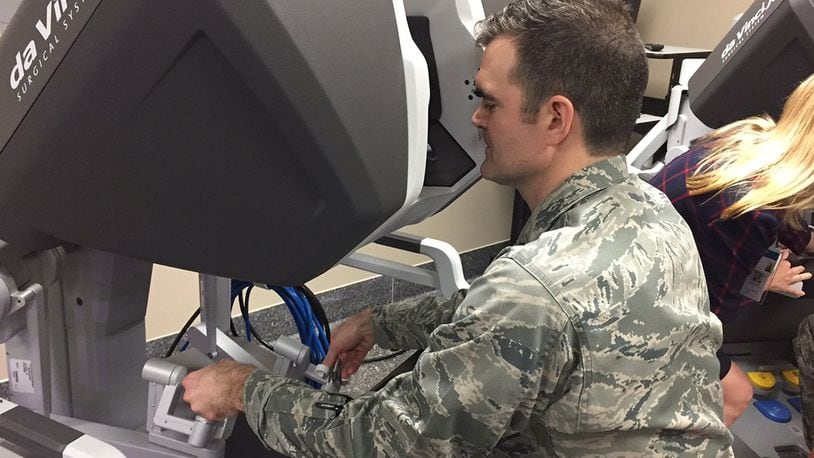“This is the standard of care for many types of surgery, and to be able to offer it on base, as opposed to off-base – which we have been doing for the last four years – is a big change and one that is going to be better for our patients,” Lees said.
He looks forward to using the da Vinci surgical robotic system on base to perform prostate, kidney and bladder cancer surgeries, he said.
Advantages of the system include increased patient satisfaction, shortened length of hospital stay and fewer complications and readmissions, plus smaller surgical incisions, he added. Additional advantages range from “phenomenal” dexterity for the surgeon to less bleeding and other benefits, Lees said.
Once support personnel and others are trained, 88 MDG general surgeons will be able to perform operations as diverse as hernia, colorectal and cancer care while base gynecologists will use it to provide appropriate incontinence and cancer care for their patients as well, he said.
“Those smaller incisions will help patients heal a lot more quickly,” Lees said.
He point outs that the robotic arms and surgical instruments move only with inputs from the surgeon, and “nothing on their own.”
With the Buckeye Federal Healthcare Consortium agreement signed in May 2015 to improve the timeliness of medical care to veterans throughout Ohio and optimize the training and readiness of personnel at the Wright-Patterson Medical Center, the 88 MDG is seeing more veterans from the Dayton VA Medical Center for the kinds of surgeries the da Vinci surgical robotic system is designed for.
“We look forward to spreading the news that we have the robotic platform here,” Lees said. “The vision is to provide efficient robotic surgical capability and excellent clinical outcomes on par with the private sector.”
The 88th Medical Group is the second in the Air Force to have the system, behind the 81st Medical Group, Keesler AFB, Mississippi. Personnel from the 88 MDG will travel to Keesler AFB for training.
“Getting our folks trained quickly and being able to spread that corporate knowledge to others in the operating room is going to be essential to make this a successful program,” he acknowledged.
“Our 88th Medical Group is world-class,” said Col. Bradley McDonald, 88th Air Base Wing commander. “We have Airmen who are providing trusted care to countless Airmen and their families, and this technology is going to continue to improve the standard and quality of care. We’re privileged to partner with our community and with the Veterans Affairs in this specific instance.”
Col. Shari Silverman, 88th Medical Group commander, said she expects surgical outcomes to improve while recovery times will shorten “quite significantly.”
“With this machine, we’re not going to have large incisions,” she said. “They will be tiny holes through which the machine will be inserted. Some of the procedures we do may even be able to done on an outpatient basis. We’re very excited about that.
“This is just one initiative to show we are really looking out for the patient, for patient safety, improving outcomes and improving quality of care, and really providing excellent customer service in everything we do,” Silverman said.
Staff Sgt. Zackery Chenevey, urology technician, said he was looking forward to the changes the da Vinci surgical robotic system will bring to his duties, as its surgical instruments are easier to switch than laparoscopic ones, and a robotic camera is built in.
Capt. Joshua Hookness, operating room nurse in charge of the urology service, said patient safety is his first and foremost concern, and he is excited to see that patients being operated on by the system are getting the most modern care.
“There is a huge variety of procedures that can be done with this method, and I know the patients are going to receive the highest standard of care,” he said.
“If a patient can now be operated on and then leave within a day or two – as opposed to something that would have taken a four- or five-day stay previously – the patient’s life and overall experience is going to be better,” Hookness said.
For more information about the da Vinci surgical robotic system, stop by the Urology Clinic at the medical center, Lees said.
About the Author
